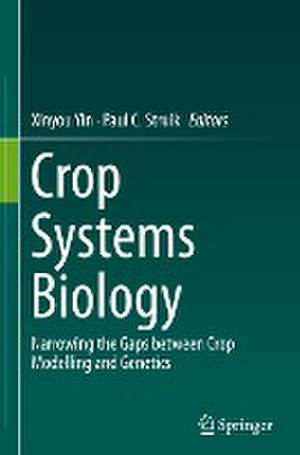Crop Systems Biology: Narrowing the gaps between crop modelling and genetics
Editat de Xinyou Yin, Paul C. Struiken Limba Engleză Hardback – 20 noi 2015
| Toate formatele și edițiile | Preț | Express |
|---|---|---|
| Paperback (1) | 619.84 lei 43-57 zile | |
| Springer International Publishing – 23 aug 2016 | 619.84 lei 43-57 zile | |
| Hardback (1) | 573.49 lei 38-44 zile | |
| Springer International Publishing – 20 noi 2015 | 573.49 lei 38-44 zile |
Preț: 573.49 lei
Preț vechi: 716.87 lei
-20% Nou
Puncte Express: 860
Preț estimativ în valută:
109.77€ • 114.40$ • 91.37£
109.77€ • 114.40$ • 91.37£
Carte tipărită la comandă
Livrare economică 01-07 ianuarie 25
Preluare comenzi: 021 569.72.76
Specificații
ISBN-13: 9783319205618
ISBN-10: 3319205617
Pagini: 250
Ilustrații: XI, 233 p.
Dimensiuni: 155 x 235 x 17 mm
Greutate: 0.63 kg
Ediția:1st ed. 2016
Editura: Springer International Publishing
Colecția Springer
Locul publicării:Cham, Switzerland
ISBN-10: 3319205617
Pagini: 250
Ilustrații: XI, 233 p.
Dimensiuni: 155 x 235 x 17 mm
Greutate: 0.63 kg
Ediția:1st ed. 2016
Editura: Springer International Publishing
Colecția Springer
Locul publicării:Cham, Switzerland
Public țintă
ResearchCuprins
Preface.- Author Index.- Chapter 1 Challenges in Integrating Genetic Control in Plant and Crop Models.- Chapter 2 Simulating Genotype - Phenotype Interaction Using Extended Functional- Structural Plant Models: Approaches, Applications and Potential Pitfalls.- Chapter 3 Modelling of Genotype by Environment Interaction and Prediction of Complex Traits across Multiple Environments as a Synthesis of Crop Growth Modelling, Genetics and Statistics.- Chapter 4 Process-Based Simulation Models Are Essential Tools for Virtual Profiling and Design of Ideotypes: Example of Fruit and Root.- Chapter 5 Heuristic Exploration of Theoretical Margins for Improving Adaptation of Rice through Crop-Model Assisted Phenotyping.- Chapter 6 Limited-Transpiration Trait for Increased Yield for Water-Limited Soybean: From Model to Phenotype to Genotype to Cultivars.- Chapter 7 Molecular Breeding for Complex Adaptive Traits – How Integrating Crop Ecophysiology and Modelling Can Enhance Efficiency.- Chapter 8 Crop Modeling Approaches for Predicting Phenotype of Grain Legumes with Linkage to Genetic Information.- Chapter 9 Modelling QTL-Trait-Crop Relationships: Past Experiences and Future Prospects.- Chapter 10 Crop Systems Biology - Where Are We and Where to Go?.- Index.
Textul de pe ultima copertă
The Work is an interdisciplinary research approach, combining modern genetics and genomics, traditional physiology and biochemistry, and advanced bioinformatics and crop modelling. It is a rapidly developing field and this book is testimony to its dynamic evolution. It provides examples of how gene regulatory and metabolic networks are included, in a spatially and temporally specific manner, in multi-scale crop modelling and how functional-structural plant modelling in combination with quantitative trait loci analysis is used to advance breeding for architectural traits. It also illustrates how prediction accuracy can profit from the large data sets available on environmental and genotypic variables by integrating physiological and statistical knowledge, and how in silico profiling can be used to unravel genotype × environment × management interactions, to analyse trade-offs between different crop characteristics or to assess yield benefits of specific traits. The Work also demonstrates very contrasting crop types that crop ecophysiology and functional modelling can assist in linking organizational scales, closing the genotype-to-phenotype gap, designing ideotypes for specific environments, evaluating suitability of specific environments for certain genotypes, and supporting model-assisted molecular breeding.
This book will appeal to those interested in bridging fundamental plant biology and applied crop science using a diversity of systems modelling approaches.
This book will appeal to those interested in bridging fundamental plant biology and applied crop science using a diversity of systems modelling approaches.
Caracteristici
The first book that describes a new research frontier in crop science Attractive for scientists from both domains of fundamental biology and applied plant science This Work could be instrumental in redefining future research agenda in crop science
